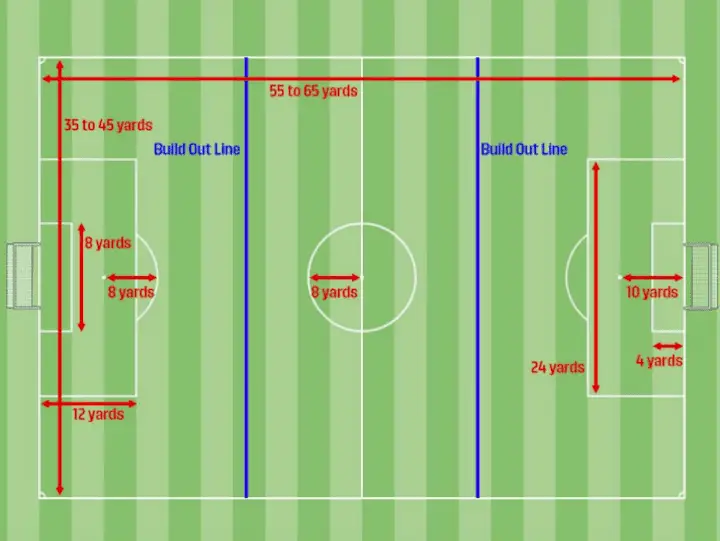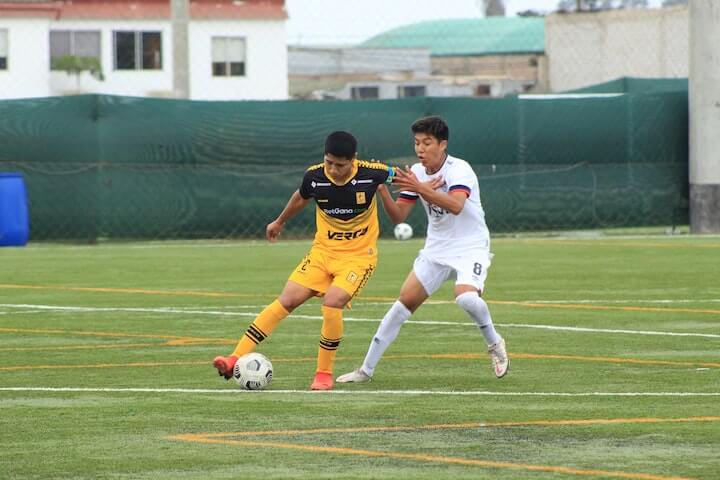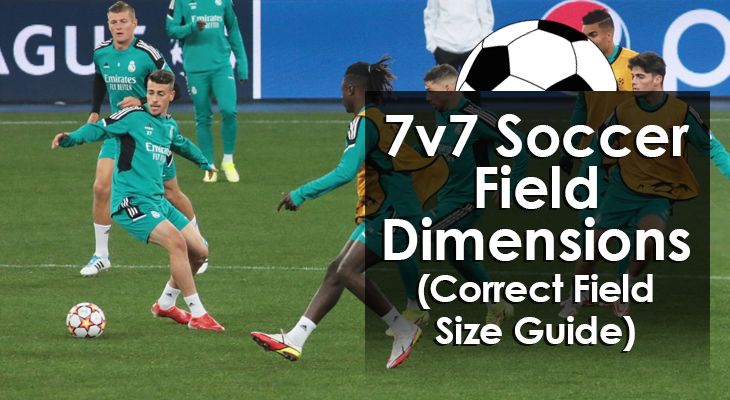7v7 Soccer Field Dimensions (Correct Field Size Guide)
7-a-side soccer is one of the most played and popular versions of the game around the world, especially at youth and recreational levels.
These games are usually played on a small field with scaled-down penalty boxes and goalposts.
The tighter dimensions make the game more accessible to youth players and those who don’t have the fitness levels for a full-on 11v11 game.
But what are the correct 7v7 soccer field dimensions?
The field size guide below lays out all the key details so you can create the optimal space for 7v7 soccer field for training and games.
7v7 Soccer Field Dimensions: Overview

Image from U.S. Youth Soccer
7v7 soccer field dimensions are important to get right, especially in youth soccer.
While adults and rec players don’t need to be fussy about having a perfectly lined field, adhering to the recommended dimensions helps younger players develop in controlled environments.
Why Correct Dimensions Are Important:
At U9 and U10 levels, bodies are still growing and kids are in a critical stage of skill development.
Providing a smaller, age-appropriate space ensures the soccer field size aligns with the players’ physical and mental capabilities.
It also helps them develop positional awareness, solid fundamentals, and partnerships with teammates on a comprehensible scale.
Playing consistently within this controlled setting is a proven way to develop player confidence, in-game intelligence, strategic movement, as well as technical on-the-ball skills.
7v7 Soccer Field Dimensions:
Let’s take a look at U.S. Youth Soccer’s standards for 7v7 soccer field dimensions:
- Field Length: 55 to 65 yards
- Field Width: 35 to 45 yards
- Build Out Line: Midway between the edge of the penalty box and the halfway line.
- Penalty Box: 12 yards long and 24 yards wide
- Goal Frame: Maximum of 6.5 feet high and 18.5 feet wide
Who decides these are the correct dimensions?
U.S. Youth Soccer implements a set of standards for all age groups, including U9 and U10 teams that compete in 7v7 games.
Any youth league associated with U.S. Youth Soccer should abide by these standards.
In most cases, the state soccer association that runs and coordinates competitions ensures that recommended playing standards are upheld in all games.

7v7 Soccer Field Length
A 7v7 soccer field should be between 55 and 65 yards long.
To give this context, a full-length soccer field is between 98 and 131 yards long with the ends marked by two parallel sidelines (or touchlines).
Interestingly, field dimensions ARE NOT uniform at any level.
Instead, each club must line its field of play within maximum and minimum limits. This lenient approach is in place to accommodate clubs with limited access to large grounds or playing fields.
It also allows each team to create their home ground to their precise specifications.
For example:
In the 1990s and early 2000s, Arsenal’s Highbury Stadium was known to have one of the largest fields in the Premier League. At the time, Arsenal played an expansive and possession-based game. The extra space gave them an advantage, often causing opponents to tire late in games as they chased the ball for 90 minutes.
7v7 Soccer Field Width
7v7 soccer fields should be between 35 and 45 yards wide.
In comparison, a full-size field should be between 49 and 98 yards according to IFAB regulations.
However, since these guidelines are quite broad, the precise specification regulations can vary between leagues.
For example, the Bundesliga (Germany) enforces a rule where all fields MUST be between 70 and 74 yards wide.
When lining your play area, note that there are three cross-field lines on a standard soccer pitch and each one runs perpendicular to the sidelines.
End lines span the width of the field on either end.
The halfway line runs across the center of the field, marking the midpoint of the play area.
And at youth level, there are also two build out lines, which we’ll discuss in the next section.
7v7 Build Out Lines
The introduction of build out lines was a directive from U.S. Soccer to promote skill development in youth leagues.
The lines work in conjunction with the build out rule, which promotes possession-based build up play from the goalkeepers and defenders.
Although the build out rule isn’t strictly enforced in all leagues, it is an excellent idea that is sure to have a tremendous impact on the development of soccer in the U.S. over the coming decades.
How Build Out Lines Work:
Two build out line markings are placed across the entire width of the field, midway between the edge of the penalty box and the halfway line on each side.
The rule comes into effect when there is a goal kick or the goalkeeper has the ball in their hands.
At this point, all opposition players get behind the line until the goalkeeper makes a pass.
The goalkeeper must pass the ball to a teammate on their side of the build out line.
They cannot punt the ball long or pass it beyond the build out line on their first pass.
This rule is in place to encourage young players to get comfortable receiving the ball close to their goal and to promote using passing and movement to progress upfield.
Once the goalkeeper makes the first pass, the opponents may cross the build out line.
The build out lines are also used to create designated offside areas.
Players cannot be offside unless they are between the opponent’s build out line and end line.
7v7 Soccer Field Penalty Box
Like the rest of the field, the penalty box dimensions are scaled down to fit a 7v7 game.
The penalty box dimensions are as follows:
- Length: 24 yards
- Width: 12 yards
- Distance from penalty spot to goal line: 10 yards
- Goal area: 4 yards long and 8 yards wide

7v7 Soccer Field Center Circle
The center circle is important for kick-offs and restarts as it provides a designated area to start play and marks where opposition players must stand before kick-off is taken.
On a 7v7 field, the center circle should have an 8-yard radius from the exact middle of the field.
The kick-off spot is a small circle, positioned midway along the halfway line.
7v7 Soccer Field Goal Frame
Under U.S. Youth Soccer regulations, a 7v7 goal frame must be no more than 6.5 feet high and 18.5 feet wide.
The organization recommends that U9s and U10s play with a goal frame that measures 6.5 feet high and 12 feet wide.
Conclusion
7v7 soccer games help players build the skills they need to compete on a full-size field.
With less space to work with, 7v7 is a lot different from competitive 11-a-side matchups.
Athleticism has less of a role to play, while there is an increased emphasis on technical skills, fundamentals, and teamwork.
These factors make it the perfect number for U9 and U10 age groups.
Our 7v7 soccer field dimensions recommendations are based on the U.S. Youth Soccer framework, so rest assured they are dependable.

